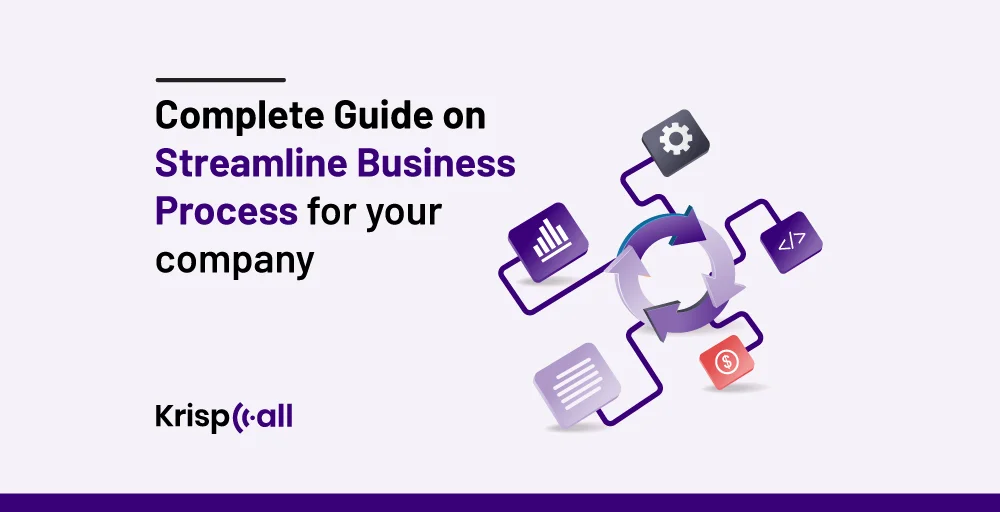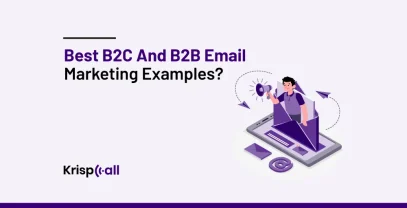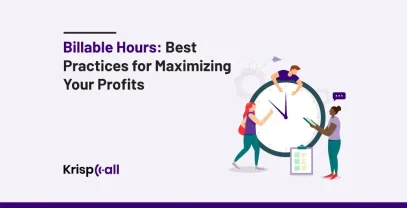Do you feel lost when it comes to streamlining business processes effectively? Or want to upgrade your existing process workflows❓
Well, you are not alone many businesses struggle with inefficient processes, it is hard to track information that gets lost between departments or even simple tasks can take forever to complete. This problem won’t be solved by your regular ideas, it requires streamlined business processes.
In this blog, you can find all the tips to streamline processes and how to implement and improve strategies. By the very end, you can transform your business into a streamlined one, boosting customer satisfaction and propelling your company forward.
🚀 Key Highlights
- Streamlining processes involves identifying and eliminating unnecessary steps or activities that don’t add value to your business.
- You can get benefits with streamlining processes in business like enhanced efficiency, cost reductions, improved quality, increased employee satisfaction, better decision-making, enhanced customer satisfaction, competitive advantage
- The best tips to improve your business processes are conducting a process audit, setting clear objectives, automating processes, standardizing processes, implementing lean principles, utilizing available technology, streamlining communication, measuring ROI, continuous improvement, regular process reviews, and feedback
- KrispCall is a cloud telephony solution, that integrates with popular CRM platforms and communication tools, helping your business with an easy-to-use dashboard and advanced telephony features.
What is streamline process in business?
Streamline process in business is identifying and eliminating repetitive and unnecessary steps or activities that provide no value in the business, which is done to add more efficiency and effectiveness.
It involves analyzing the business process, identifying blockheads, and implementing solutions to ensure inquiries reach the right person quickly and efficiently.

To understand💡 how a streamlined process works in business here is an example: Imagine customers getting frustrated with long wait times and slow responses to inquiries, this could lead to negative reviews, and lost sales. By streamlining customer service response time you can faster response time, and improve customer satisfaction.
Aberdeen Group found that companies with standardized processes experience a 33% reduction in operational costs. This translates to more work getting done in less time. It also prioritizes customer experience which can increase revenue compared to its competitors by 6% to 8% according to PwC.
What are the benefits of streamlining processes in business?
Streamlining processes in your business offers multiheaded advantages that can significantly impact your overall business process and help obtain your target. Here’s a closer look at some key benefits:
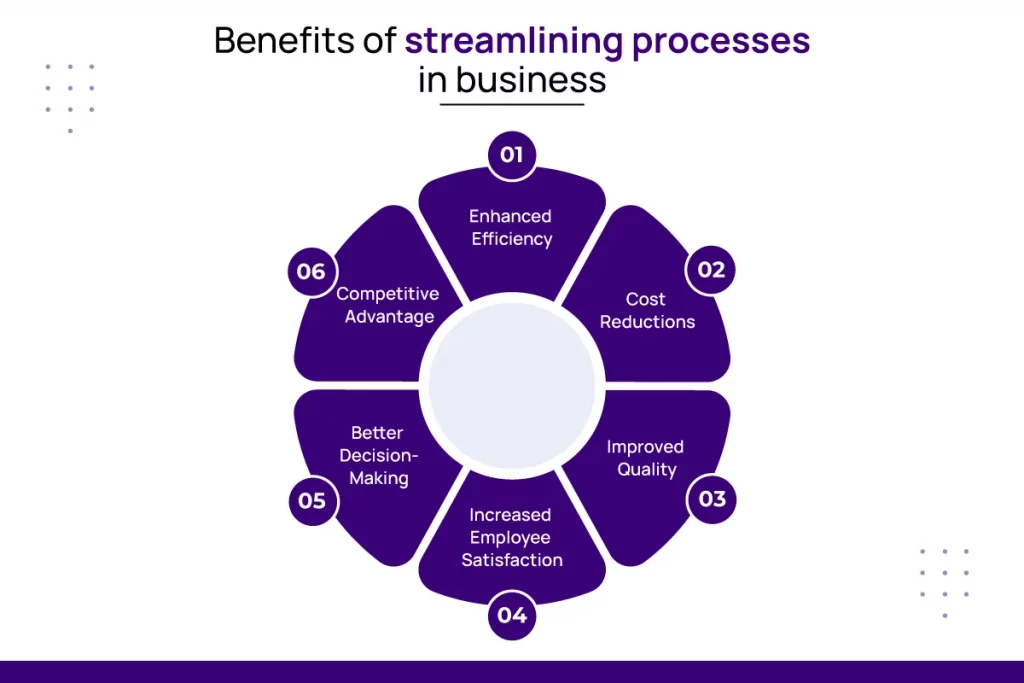
- Enhanced Efficiency: Streamlining can help you eliminate redundancies and unnecessary steps, which allow your team to work smarter, not harder. This results in completing tasks faster, improved productivity, and the ability to handle more workload.
- Cost Reductions: Streamlining often involves establishing clear procedures and quality control measures. By implementing a streamlined process you can utilize the amount towards expanding your business or pursuing other important goals.
- Improved Quality: Improved quality usually means making sure everything meets certain standards. This means to 📉reduce mistakes and differences, which ultimately leads to better work and results.
- Increased Employee Satisfaction: Streamlined processes make work less frustrating and time-consuming for employees. When the expectations of the business are clear, workflows are smooth, and workloads are lighter, it can boost job satisfaction among your employees.
- Better Decision-Making: Streamlining often involves gathering data and analyzing the business process. With the gathered data you can make informed decisions about resource allocation, process improvements, and strategic direction.
- Competitive Advantage: When you streamline how things are done, you get ahead of competitors who are still dealing with problems. You can offer better products and services more quickly, which helps your business grow.
10 best ways to streamline process for your business
Efficiency is the lifeblood of any successful business. Streamlining processes eliminates unnecessary steps, reduces wasted time, and frees up resources for what truly matters. Here’s a breakdown of some key strategies to optimize your workflows:
1. Conduct a Process Audit Before You Automate It (Don’t Automate Chaos)
If you are thinking of automating any action, it is better to conduct a thorough audit process. By conducting a process audit you can identify possible opportunities and weaknesses along with areas for improvement.
Companies that automate well-defined processes experience a 20-50% reduction in processing costs. However, automating a flawed process can amplify inefficiencies.
McKinsey & Company
It’s better to understand the process itself and make sure it’s efficient. Imagine trying to clean a dirty room with a fancy new vacuum cleaner. If the room is cluttered with furniture, the vacuum won’t be very effective. Similarly, automating an inefficient process won’t make it much faster or better.
2. Set Clear Objectives (Know Your Destination)
The main object must be clear on what you want to achieve through streamlining the process in your business. Every object is different for example are you trying to reduce error? Lower cost? Or improve turnaround times? Specific Object helps you measure the whole process and make data-driven decisions.
Companies with a clear vision for process improvement efforts achieve 30% greater efficiency gains.
Harvard Business Review
To roadmap your business success the objective must be SMART: Specific, Measurable, Achievable, Relevant, and Time-bound. By setting clear, measurable goals, you can track progress, identify roadblocks, and celebrate achievements. These objectives keep everyone on the same page and ensure your streamlining efforts are targeted toward achieving the desired outcomes.
3. Automate Repetitive Tasks (Free Up Your Workforce)
Did you know🤯 that a significant amount of time from you and your employee’s workday is being consumed by repetitive tasks? At the same time, these repetitive manual tasks are prone to errors. Automating such tasks through technology can deliver tons of benefits for your business.
80% of current activities across industries could be potentially automated. This translates to a significant reduction in time spent on mundane activities.
McKinsey & Company
For example: Imagine your marketing team released from the responsibility of organizing social media posts, or your customer service team relieved of repetitive data entry tasks. This extra capacity enables your team to dedicate their efforts to more impactful tasks, such as developing strategic marketing initiatives or enhancing personalized customer experiences.
4. Standardize Processes (Consistency is Key)
It sure is important to develop a clear and consistent strategy for common tasks. Standardizing processes in your business is essential for streamlining operations as it ensures consistency across different departments and teams.
Companies with standardized processes experience 33% lower operational costs.
Aberdeen Group
Within the healthcare industry, standardizing processes regarding patient data handling ensures privacy regulations like the Health Insurance Portability and Accountability Act (HIPAA) in the U.S., thereby safeguarding sensitive information and fostering patient confidence.
5. Implement Lean Principles (Eliminate Waste)
Lean principles are a powerful philosophy adopted by industry leaders worldwide to streamline workflows and maximize value. Imagine a scenario where a customer inquiry goes through a labyrinthine process, taking days to resolve. Lean principles can help eliminate such blockage. Analyze your workflows to identify and eliminate any non-value-added activities.
By implementing Lean Principle companies can reduce rework(fixing errors) by up to 80%.
Lean Enterprise Institute
Lean keeps the customer at the center of everything. By mapping out your value stream (all the steps involved in delivering a product or service), you can identify unnecessary steps that don’t contribute to customer satisfaction.
6. Utilize Available Technology Solutions (Embrace the Tools)
There are numerous technologies available in the market which provide solutions to your business need but you must be able to identify the right one. Project management tools allow managers to organize tasks and track deadlines.
Whereas, communication platforms facilitate collaboration, and data analytics tools help analyze data to provide valuable insights to optimize workflows. With the right technology, you empower your employees to work smarter, not harder, ultimately leading to streamlined processes and a more efficient business.
Businesses that utilize cloud-based collaboration tools experience a 20% increase in team productivity.
Frost & Sullivan
With cloud technology you can foster a collaborative work environment, ensuring everyone is on the same page and projects move forward smoothly by sharing documents, communication channels, and easy access to project updates.
7. Streamline Communication Process/Channel (Break Down Silos)
Streamlining your communication processes helps you create a clear and efficient flow of information, fostering collaboration and boosting productivity within the business. All you need to do is implement a telephony system such as KrispCall that integrates all your needs- calls, SMS, email, voicemail, and business phone numbers into one central hub.
Having poor communication can cost businesses up to $400 billion per year in lost productivity.
Salesforce
Companies with a strong culture of transparency experience 26% higher employee satisfaction and a 28% increase in profitability.
Report by Towers Watson
Investing in the right tools and encouraging their use should not be considered expenses. It empowers your team to communicate effectively and efficiently, which leads to a more productive and streamlined work environment.
8. Check the ROI of Automation (Measure Your Success)
You can streamline your business process as much as you want to automate tasks but how do you know if it’s actually paying off? Well, this is where ROI(Return Of Investment) comes into play. When you get proper ROI, you get financial benefits, ensuring your streamlining efforts translate to your business effectively.
You can calculate ROI with a simple formula: ROI = (Benefits – Costs) / Costs x 100%. For automation, benefits could include reduced labor costs, faster processing times, and fewer errors. Meanwhile, costs include software licenses, associated fees, and ongoing maintainers fees.
Tracking ROI can really help you figure out if using automation is the right move for your business processes. According to UiPath research, companies that track how automation impacts their ROI are more likely to reach their goals.
9. Embrace Continuous Improvement (It’s a Journey)
When you implement streamline business processes it doesn’t end there, it’s not a one-time fix; it’s an ongoing philosophy known as Continuous Improvement. This process clarifies that your business needs and technologies evolve with time and your processes should adapt accordingly.
One of the core principles of continuous Improvement is Kaizen, which means “change is better” in Japanese. Having continuous small improvements is said to be better than drastic changes.
20% higher profit margin in real-time can be achieved by continuous improvement
Study by PWC
Embracing continuous Improvement is a journey that increases efficiency, adaptability, and employee engagement within your business. It’s a culture that constantly evaluates and refines processes, adapting to market change, and empowering employees to identify and solve problems.
10. Conduct Regular Process Reviews and Feedback (Gather Insights)
Implementing streamlining processes refers to getting half of the job done while conducting regular process reviews and feedback is what you need in your business. Regular process reviews refer to systematically assessing your streamlined workflow to help you identify areas for improvement.
The easiest and most effective review and feedback processes you can conduct are through the people who are working within the company or people who use these processes daily. You can get valuable insights through surveys, focus groups, or one-on-one discussions.
Companies that encourage employee feedback experience a 17% increase in productivity.
Study conducted by SHRM
There are major benefits of regular reviews and feedback such as proactive problem-solving to identify and address potential issues ahead. Continuous improvement to refine our streamlined processes and finally employment engagement that fosters a sense of ownership within your team.
By implementing these strategies, you can optimal resource utilization in your business. It’s important to understand there are other business improvement methodologies, whereas streamlining is an ongoing journey, not a destination. By embracing continuous improvement, leveraging technology, and empowering your employees you can create a more efficient and successful organization.
Streamline Business Contacts, Calling, Texting, & More With KrispCall Integrations
Frustrated😣 with juggling multiple contact lists and communication platforms? Look no further KrispCall integration is here to streamline your business processes.
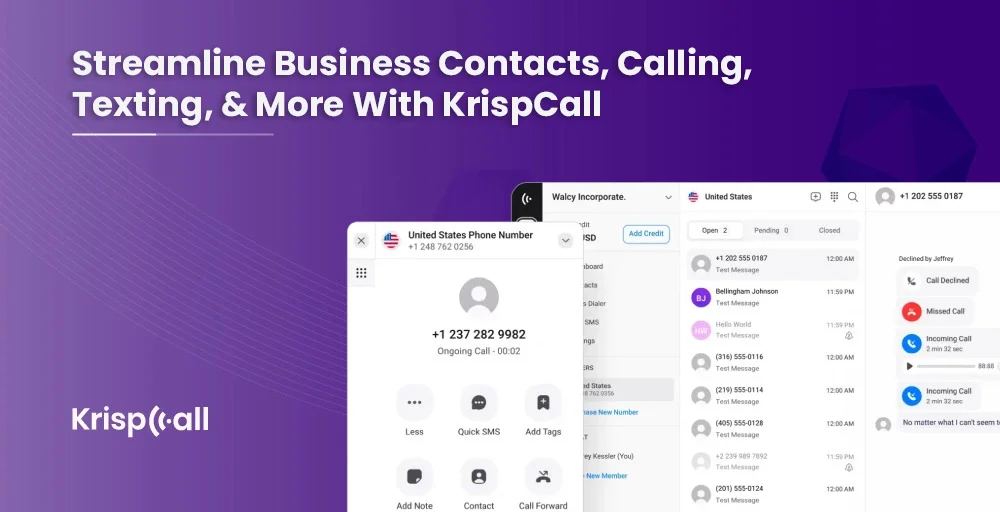
In the recent business environment, it’s important to centralize all your contacts, make them accessible from anywhere, and easily integrate with your calling, texting, and other communication needs. KrispCall integrations help you achieve these solutions by offering integration with popular Customer Relationship Management (CRM) platforms and communication tools.
With a cloud telephony system, you can access advanced features like Unified callbox, global calling, SMS, voicemail, shared phone number, call forwarding, IVR, call analytics, call recording, and more that boost your business productivity. It allows you to focus on what matters most during business operations such as building relationships and growing your business.
You’ll experience increased efficiency, improved customer service, and a more cohesive workflow for your entire team by implementing KrispCall for your business. With subscription plans starting at $15/month, you can unlock unlimited potential that can smooth your business communication.
Conclusion
In today’s competitive business landscape, streamlining processes is no longer optional, it’s essential. By eliminating inefficiencies and optimizing workflows, you can free up valuable resources, boost productivity, and enhance customer satisfaction.
Remember, streamlining is an ongoing journey. Regularly evaluate your processes, embrace new technologies like cloud-based communication solutions from KrispCall, and empower your employees to continuously improve.
With KrispCall’s seamless integrations and features designed for efficiency, you can transform the way your business communicates and operates, achieving a smoother workflow and a significant edge over the competition. So, take the first step towards streamlining your success – explore the KrispCall free demo today for your business.

